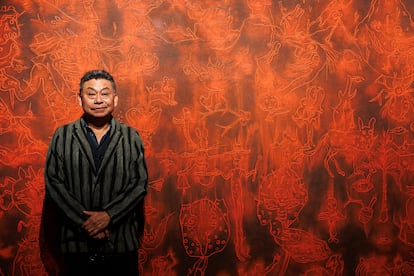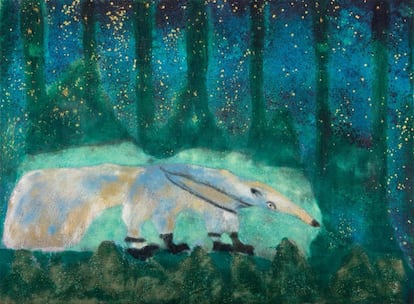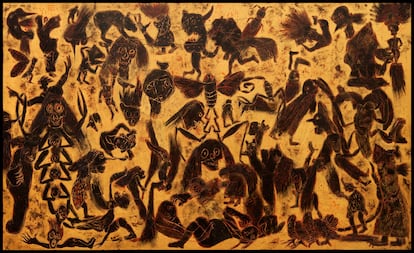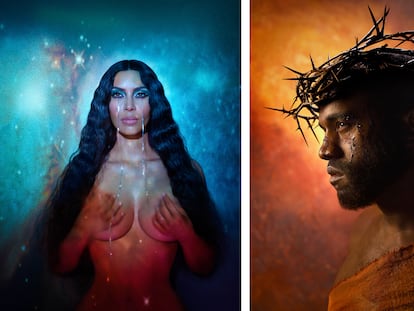Sergio Hernández and the spirit of the anteater
The acclaimed Oaxacan painter is showing his work in the United States for the first time in his 40-year career


The world of Mexican painter Sergio Hernández is a menagerie of bugs and imaginary creatures. The Oaxacan artist takes them from his dreams and nightmares and exorcises them onto canvas, using sand, lead, and even gold. Of all the lifeforms in his vast and fantastical catalogue, one stands out among the rest – a creature not of other worlds, but of this one: the anteater. “In the zoo of my Oaxacan soul, among the insects and axolotls, an anteater has lived for a long time; he has visited me in my dreams ever since I visited him one day at a zoo in Berlin,” Hernández told EL PAÍS.
The anteater is a central feature of Hernández’s latest exhibition, Embers of Oaxaca, which opened on November 12 at the San Diego Museum of Art. The show is a retrospective of the artist’s more than four-decades-long career. The Mexican tamandua, a type of anteater featured prominently in Hernández’s work, is made out of various pigments and sands. It is a work of gratitude, dedicated to his nahual – the protective animal spirit of pre-Hispanic Mesoamerican societies. “It is my tona [a concept similar to a totem], protecting me in transit through this underworld that is the 21st century,” Hernández says. In exchange for this protection, the painter dresses the tamandua in “mineral blue” and “barite green,” two colors he believes are among the animal’s favorites.
The nahual’s magic has worked well for Hernández, who is now 65 and has had the privilege of living several lives. It is also an ember that burns in his memory, left over from the stories his grandmother would tell him to lighten the hardships of his childhood in Santa María Xochistlapilco, a region in the Mixtec highlands of northwest Oaxaca. “It’s a living ember of her cooking, lingering in my memory,” he says. The anteater, he adds, comes to him when he calls and is always by his side.

Open through February 12, 2023, Embers of Oaxaca is a testament to the good fortune this protective spirit has provided him. The show is Hernández’s first solo exhibition in a US museum – a surprising milestone considering the artist’s status as one of Mexico’s most renowned painters. He is a graduate of the prestigious La Esmeralda School of Art in Mexico City, and his early works were selected for the Salón de Artes Plásticas de Bellas Artes in 1977. In 1984, he was invited to participate in the first Havana Biennial.
Following his early success, Hernández went on to study graphic production at Peter Bramsen’s workshop in Paris, an obligatory rite of passage for European creators. In France, he met Oaxacan artist Francisco Toledo, with whom he shared not only a common terroir, but a fertile imaginary world as well. Teresa del Conde, one of the most influential Mexican art critics of the late 20th century, argued that, despite the existence of masters like Rufino Tamayo and Francisco Toledo, there was no such thing as an Oaxacan school of art. But, she said, Hernández, more than anyone, represented the “essence” of Oaxacan art through “the iconography of his diverse motifs, the reticles that govern his compositions, and his use of color.”
The 33 works featured in Embers of Oaxaca offer a brief summary of a career that has spanned more than 40 years. Hernández’s most classic pieces – large canvases covered in pigments of sulfur, cinnabar and Lapis Lazuli, the color used by Fra Angelico during the Renaissance – are on display, welcoming visitors at the entrance. Then there are pieces painted specifically for the exhibition. Among these are five mixed-media paintings featuring an array of magical fauna, composed on a canvas of gold leaf. This is the first time that Hernández uses this element in his work.
Another noteworthy section features a selection of Hernández’s work from seven years ago. When it was originally shown in 2015, the series was titled Blanco de plomo (Lead White), in reference to the process Hernández used to create the dreamlike and apocalyptic landscapes, employing white paint (lead white is one of the oldest synthetic pigments in the world) on metal canvases. In these works, Hernández invokes the spirit of an alchemist, pouring acid, vinegar, malachite, turquoise and other pigments onto metal sheets, revealing figures at first only visible to the artist. Hernández often works with a respirator to avoid breathing the toxic substances aerosolized during his process.

Roxana Velásquez, who has served as the director of the San Diego Museum of Art for the past 12 years, decided to open the institute’s doors to Hernández and his unique artistic worldview after the two met in 2019 at the Feria Marco in Mexico City. California, and the border town of San Diego in particular, offered an ideal location for Hernández’s first US exhibition. The state is home to hundreds of thousands of Oaxacan immigrants – a fact inspiring its unofficial designation as “Oaxacalifornia” – who have brought their linguistic, dress, and, above all, culinary traditions with them, to the benefit of the state’s major cities, especially Los Angeles.
Hernández agreed to have the show in San Diego because crossing the border would allow him to bring his ideas and art to a new place and a new audience. He also knew his work would be in good company: The San Diego Museum of Art has a small but impressive selection of works by masters such as Zurbarán, José de Ribera, El Greco, Murillo, Sorolla, Juan Sánchez Cotán and Giorgione, a mysterious, 15th-century Italian genius with question marks surrounding the authenticity of his identity. Hernández says that he felt a sense of belonging there, in the company of the European masters who influenced him.
Belonging is one of the main themes of Embers of Oaxaca. Hernández uses materials from his homeland – sands, cochineal (a red pigment), and other colors derived from regional insects – to create art using the environment that surrounds him. His paintings reflect the hidden wonders of the natural world – of the native plants and animals he grew up with. And now, Hernández is migrating these wonders, and this sense of belonging, to the other side of the border. He has even offered to donate “Oso hormiguero,” the anteater piece, to the museum’s permanent collection. The artist is letting go of his protector.
Sign up for our weekly newsletter to get more English-language news coverage from EL PAÍS USA Edition
Tu suscripción se está usando en otro dispositivo
¿Quieres añadir otro usuario a tu suscripción?
Si continúas leyendo en este dispositivo, no se podrá leer en el otro.
FlechaTu suscripción se está usando en otro dispositivo y solo puedes acceder a EL PAÍS desde un dispositivo a la vez.
Si quieres compartir tu cuenta, cambia tu suscripción a la modalidad Premium, así podrás añadir otro usuario. Cada uno accederá con su propia cuenta de email, lo que os permitirá personalizar vuestra experiencia en EL PAÍS.
¿Tienes una suscripción de empresa? Accede aquí para contratar más cuentas.
En el caso de no saber quién está usando tu cuenta, te recomendamos cambiar tu contraseña aquí.
Si decides continuar compartiendo tu cuenta, este mensaje se mostrará en tu dispositivo y en el de la otra persona que está usando tu cuenta de forma indefinida, afectando a tu experiencia de lectura. Puedes consultar aquí los términos y condiciones de la suscripción digital.
More information
Archived In
Últimas noticias
Most viewed
- Oona Chaplin: ‘I told James Cameron that I was living in a treehouse and starting a permaculture project with a friend’
- Sinaloa Cartel war is taking its toll on Los Chapitos
- Reinhard Genzel, Nobel laureate in physics: ‘One-minute videos will never give you the truth’
- Why the price of coffee has skyrocketed: from Brazilian plantations to specialty coffee houses
- Silver prices are going crazy: This is what’s fueling the rally










































